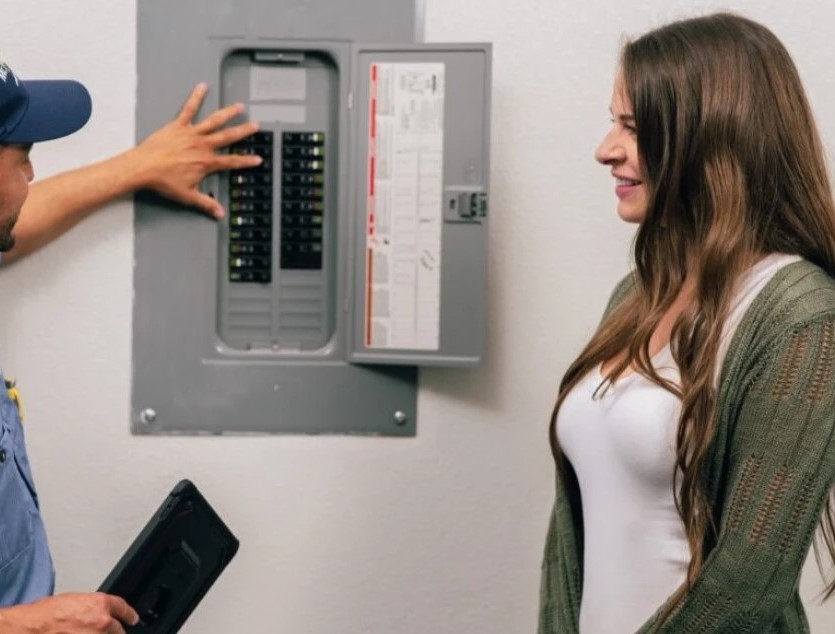Key Takeaways
- Frequent breaker trips signal an electrical problem.
- Common causes include overloaded circuits, short circuits, ground faults, faulty appliances, and aging wiring.
- Warning signs like repeated trips, burning odors, or flickering lights require immediate professional attention.
- Regular electrical inspections and panel upgrades are effective ways to prevent future breaker problems.
When a circuit breaker keeps tripping, it signals that something in your electrical system needs attention. This can range from a temporary overload to a serious fault that could put your home at risk.
For you, understanding what causes this and how to address it can prevent damage, improve safety, and avoid costly repairs.
The Role of a Circuit Breaker
A circuit breaker is a safety mechanism that cuts power when electrical flow goes beyond the safe capacity of the wiring. This prevents wires from overheating, which can lead to fire hazards or damage to connected appliances. Every trip is a deliberate action to protect the system. The goal is to determine why it happened so that it can be corrected.
Causes of a Tripping Breaker
Overloaded Circuits
This is the most common cause. An overload happens when too many devices are connected to one circuit at the same time. For example, running a portable heater, a hair dryer, and a clothes steamer on the same circuit will likely exceed its limit. The breaker shuts off to stop overheating.
Short Circuits
A short circuit occurs when a hot wire touches a neutral wire or a ground wire. This allows an immediate surge of current, which the breaker interrupts almost instantly. Short circuits can be caused by damaged wires, loose connections, or faulty devices. They are a serious hazard and should be inspected immediately.
Ground Faults
A ground fault is similar to a short circuit but occurs when a hot wire contacts a grounded surface. This is common in damp or wet locations, such as bathrooms, kitchens, or outdoor outlets. Ground Fault Circuit Interrupter (GFCI) outlets are designed to detect and trip in these situations.
Defective Appliances
Some appliances develop internal wiring problems that cause breakers to trip. If moving the device to another outlet causes the breaker there to trip as well, the appliance is likely the problem.
Aging or Damaged Wiring
Older homes often have wiring that was never intended for today’s electrical demands. Over time, insulation can break down and connections can loosen. This increases the risk of shorts, overloads, and overheating. Professional evaluation is essential in these cases.
Warning Signs That Require Immediate Action
Not every trip is a sign of a major issue. However, certain patterns should never be ignored:
- The same breaker trips repeatedly within weeks.
- A faint burning odor is noticeable near outlets or the breaker panel.
- Lights flicker when appliances start or when multiple devices are used.
- Breakers feel warm to the touch.
These are all indicators that there may be a hidden fault that requires professional service.
Expert Tips and Tricks for Troubleshooting
Know the Panel Layout
Label every breaker in your electrical panel. This helps identify which outlets and appliances are affected, saving time during troubleshooting.
Reset Safely
If a breaker trips, unplug all devices on that circuit before turning it back on. Then plug devices in one by one to find if a specific item is triggering the trip.
Avoid Circuit Overload
Distribute high-wattage devices across multiple circuits. For example, avoid running a coffee maker and toaster oven on the same kitchen outlet.
Upgrade When Needed
If your home has an older breaker panel or your electricity needs have grown, a service upgrade can help prevent tripping from everyday use.
Why Professional Help Matters
While basic checks can be done safely at home, persistent breaker trips often require tools and expertise that only licensed electricians have. Professionals can measure current loads, use thermal cameras to detect hotspots, and test insulation resistance to locate hidden problems. This approach solves the cause instead of simply treating the symptom.
Preventing Future Breaker Trips
Preventive maintenance is the most reliable way to avoid nuisance trips. Annual inspections, replacing worn outlets, upgrading outdated wiring, and adding dedicated circuits for high-demand appliances all help reduce stress on your electrical system.
A well-maintained system runs more efficiently, lasts longer, and keeps your household safer.
Summary
A breaker that keeps tripping is your electrical system’s built-in warning signal. It should never be ignored. By knowing the possible causes, recognizing the warning signs, and taking action early, you can protect your home and avoid more expensive repairs.
Safe Electric has the knowledge and equipment to diagnose the problem and restore safe operation quickly.
FAQs
Can I keep turning a breaker back on if it trips?
No. Repeatedly resetting without fixing the cause can cause heat buildup and damage. The underlying issue must be addressed.
How can I tell if the breaker itself is bad?
A breaker that trips even with no load or feels hot when switched off may be faulty. An electrician can confirm with testing.
Is it okay if a breaker trips once in a while?
Occasional trips are normal during heavy use. Frequent trips point to an electrical problem.
What is the difference between a short circuit and a ground fault?
A short circuit is contact between hot and neutral wires. A ground fault is contact between a hot wire and a grounded surface.
Should I replace my breaker panel if it is more than 30 years old?
Yes. Older panels may not handle today’s electrical loads and could have worn parts that fail to protect properly.
How can I prevent overloading a circuit?
Limit the number of high-wattage devices used at the same time and spread them across different circuits.

